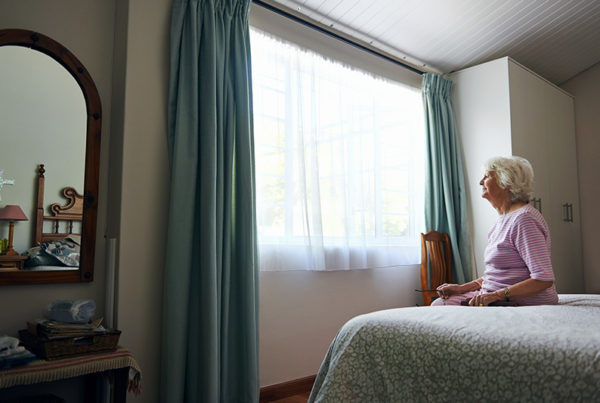Prepare to age in place while avoiding that dreaded “nouveau nursing home” look that makes you cringe.
Many of us are getting older and looking around our current home makes us realize that it’s not going to fit our needs in future years. Perhaps our parents are aging, and it’s only a matter of time until we need to take them in under our roof to keep them safe and comfortable. Or maybe we’re looking to downsize, and we want to do some remodeling on the “new” house before we move in so that it fits our needs for the rest of our life.
But…we’re secretly a little worried, or maybe a lot worried, that the end result will make our cozy home look like nursing central, with an IV bag and portable bed the only missing items. “I’m too young for that!” we think, no matter our age. We still want to entertain friends, dance to the radio, have a glass of wine and play Twister with the grandkids. So what do we do?
Age-proofing is no longer synonymous with linoleum floors and industrial-strength grab bars. Thank goodness! There’s a whole new world of products that cater to tasteful design, and may even enhance the coolness factor of your current abode. Who doesn’t want a teak shower seat?!
Hire an expert
If you want a professional look, hire a professional remodeler. No matter who works on your home, your contractor and any sub-contractors should have a license (so they can pull permits from the municipality or county), insurance (to back up their work) and a bonding certificate (to pay up if they steal from you or fail to perform contracted work). If they can’t show you these documents, show them the door. Otherwise, you may be out of luck with inferior workmanship, failure to pass code or even someone who takes your deposit and leaves town.
Find a pro who has done aging in place remodels many times, can show you before and after photos and is willing to provide references. Ask if the project was done on time, without cost overruns. One way to vet local contractors is to use Nextdoor to ask your neighbors their opinion, or pay a small fee for an Angie’s List recommendation. Be a savvy shopper. Home Advisor is in business to sell advertising and offers absolutely no guarantee to the consumer.
You might also want to contact some Certified Aging-in-Place Specialists (CAPSs). These are remodelers, designers, occupational therapists and architects who have gotten specialized training from the National Association of Home Builders. Talk with several on the phone, then ask your favorites for an in-home consultation. Hire someone who can work in your timeframe and budget.
Finally, we have nothing against a local handyman who has demonstrated his ability to do the scope of work you have in mind. Before you hire him, read our advice, above, and make sure he fills the bill on all counts.
Around the House
Generally, you’ll need more light as you get older. Installing automatic lights at outside doors helps illuminate your path at dusk and early morning. Check your indoor lighting, too. It’s often less expensive to buy additional lamps than to install lighting. In closets, try something like this motion-detector LED light bar for under $20, or a Luna tap light for less than $10.
Reduce furniture and clutter throughout your home for greater freedom of movement. About three feet is enough room for a wheelchair or walker to get through. Consider lowering switches for greater accessibility by people of all heights. Rocker light switches are easier for arthritic hands than those requiring pinching or grasping. Switch circular doorknobs to lever hardware and benefit even if you’re just coming in from the garage with hands full of groceries.
In the laundry room, front-loading machines on pedestals are the easiest to access. Switch from liquid detergent to powder to reduce weight. And for safety at the sink or in the bathroom, lower the heat on your hot water heater to a maximum of 120 degrees to avoid burns.
Rethinking the Stair Lift
Like many homes, yours may not have a full bath on the main floor. This may force you to think that your only option for a move-in parent who can’t climb stairs is to install a chair lift. These can be pricey, whether you buy or rent.
One alternative is to consider turning a main floor living room, den or family room into a bedroom space. A shower rod outfitted with new curtains may be all the investment you need to provide privacy, or try some inexpensive room dividers from IKEA, Bed Bath and Beyond, or Pier 1.
Use the money you save from the stair lift to add a wet room or shower to the main floor bathroom. Many contractors have become experts at this trick, so the improvements look high-end. It should add value to your home when and if you sell, as an added benefit.
Around the Kitchen
A shallow sink is ideal, with the faucet on the side, rather than at the back, for easy access. Adding pull-out shelves can be a lifesaver for people with diminished eyesight or mobility. You can find these shelves at home improvement stores. “D” shaped handles are the easiest for most people to grab. Hardware that is on the large side will be easier to grasp, opening up a wide range of stylish options.
Appliances should have easy-to-read knobs and dials with big, high-contrast letters and numbers. Even better are those that display information with an intuitive image. Illuminated water and ice dispensers are a boon on the fridge, as is a long door handle with multiple gripping points. Top-mount models with the freezer (used less often) underneath are also a good choice.
If you’re in charge of a new build, or remodeling old cupboards, consider raising the height of countertops, or leave space underneath for a wheelchair to fit. Standard countertop heights are not ideal for people of different heights, or for different uses. For example, it may be easier to roll out biscuits on a high counter and leave the rest lower.
Principles of Universal Home Design
Universal design is a simple concept. Products and environments should be friendly to all people, whether or not they have special needs. It goes hand-in-glove with aging in place. More and more homes are built with these principles in mind, to cater to a growing segment of the population. Review these tenets of universal design, and think how your own home stacks up.
- Equitable use. A group of people with diverse abilities would find your home equally easy to use.
- Flexibility of use. Individual preferences (such as right-or left-handedness) are accommodated.
- Simple, intuitive use. Lighting systems, appliances and bathrooms don’t require special knowledge, language skills or concentration to understand and use.
- Accessible information. The design says it all, regardless of ambient conditions or sensory abilities. Pictures or audible or tactile methods communicate information.
- Tolerance for error. The design is forgiving, minimizing hazards and the consequences of accidents or fatigue. The most-used elements are most accessible.
- Low physical effort. Efficiency and comfort dictate design.
- Adequate size and space. Room is provided for approach, reach, manipulation and use, no matter the size, posture or ability of the user.
Bomber Bathrooms
Adequate size and space. Room is provided for approach, reach, manipulation and use, no matter the size, posture or ability of the user.
There’s no room more important than the bathroom for aging in place. We use them all day long, and they have wet zones, which increase the possibility of slips and falls. But we also want them to look beautiful, and giant grab bars don’t jibe with that image. Fear not; accessible bathrooms have come a long way.
Let’s start with the shower bench. You can have one built right into your custom shower. Add some waterproof cushions to pad your tush. If you prefer the flexibility of a removable bench or seat, there are plenty of options besides the plastic and steel version at Walmart (which is plenty serviceable in a pinch). To take it up a notch, try something in teak that tickles your fancy and goes with any décor. Teak wood can take the abuse of daily hot showers and still look good. If you’re pressed for space, try this fold-up version.
Know what else you need? A handheld shower head, especially one that travels up and down a pole to adjust the height of the spray, helps reach every spot. They’re getting to be ubiquitous in tiney homes, so it’s easy to find a model to fit your style for under $200.
Now, about those grab bars. They can serve double duty as towel racks, and they don’t have to be as big as your arm in stainless steel. Check out Moen grab bar styles, just to show you what one company offers. Choose your style and choose your finish. (Our favorite is the Old World Bronze). To be sure, some of the models are a bit … hospital bathroom style, shall we say? But we have choices!
You might want to increase the height of your vanity (sinks and counters, for those of us who didn’t know we had a vanity). Standard installation is 31 ½ inches, including the countertop. If you’re on the taller side, try having them put in at 34 ½ inches, which is standard counter height in the kitchen, to prevent from hunching over to wash your face. Caveats are for short people and those in wheelchairs. Wheelchair-accessible counter heights are 34 inches maximum as specified in the Americans with Disabilities Act guidelines.
As muscle mass declines, standing and rising from the sitting position can become difficult. Make your life easier with a “comfort-height” toilet. They’re 17 to 19 inches high, versus the standard 16-inch potty. And there are companies out there making them beautiful! Choose one that is an exact style match to your pedestal sink, or one that blends into your contemporary scheme. There are even toilets that disguise the little wiggle drain in the porcelain, so you don’t have to be reminded what that luscious piece of art is really for. Check here for your favorite comfort toilet style.
Glass walls and doors are the rage for opening up a smaller bathroom space, but they’re a pain in the comfort toilet zone to clean. It’s unlikely that you’ll want to squeegee those walls when you’re 85 (although if you can’t see they’re coated in water spots, you might not care). So if that’s an issue, or if you just hate cleaning those dang doors right now, try an open shower. If you have the space, remodelers can put in one that has a gradual slant toward the drain and no curb to step over. While you’re at it, wire in a light above the shower and one where you step out.
Porcelain wall and floor tiles are super durable and easy to clean. If you hate grout, ask for porcelain floor tile with a rectified edge. These allow for tiny grout joints as small as 1/16 inch, and you can still use pre-sealed grout. Your flooring needs to have high slip resistance, whatever you use. Look for grooves or feel the texture. Tile is rated by measuring the coefficient of friction, which can usually be found on the manufacturer’s website.
Now you know that your home can be stunning at the same time it’s ready for you to age in place. No matter what your taste, the kitchen and bath can have increased functionality without losing any of your style. Changes can be made all at once or over time, depending on your budget. Making your home safer may allow you to live independently for many years longer, and perhaps for the rest of your life.
Sources:
https://www.huffingtonpost.com/entry/how-to-age-proof-your-home_us_5942d034e4b01eab7a2c41f4
https://www.hgtv.com/remodel/interior-remodel/how-to-age-proof-your-remodeling
https://www.houzz.com/ideabooks/60576589/list/11-ways-to-age-proof-your-bathroom
https://www.hgtv.com/remodel/interior-remodel/universal-design-principles
Blog posting provided by Society of Certified Senior Advisors





